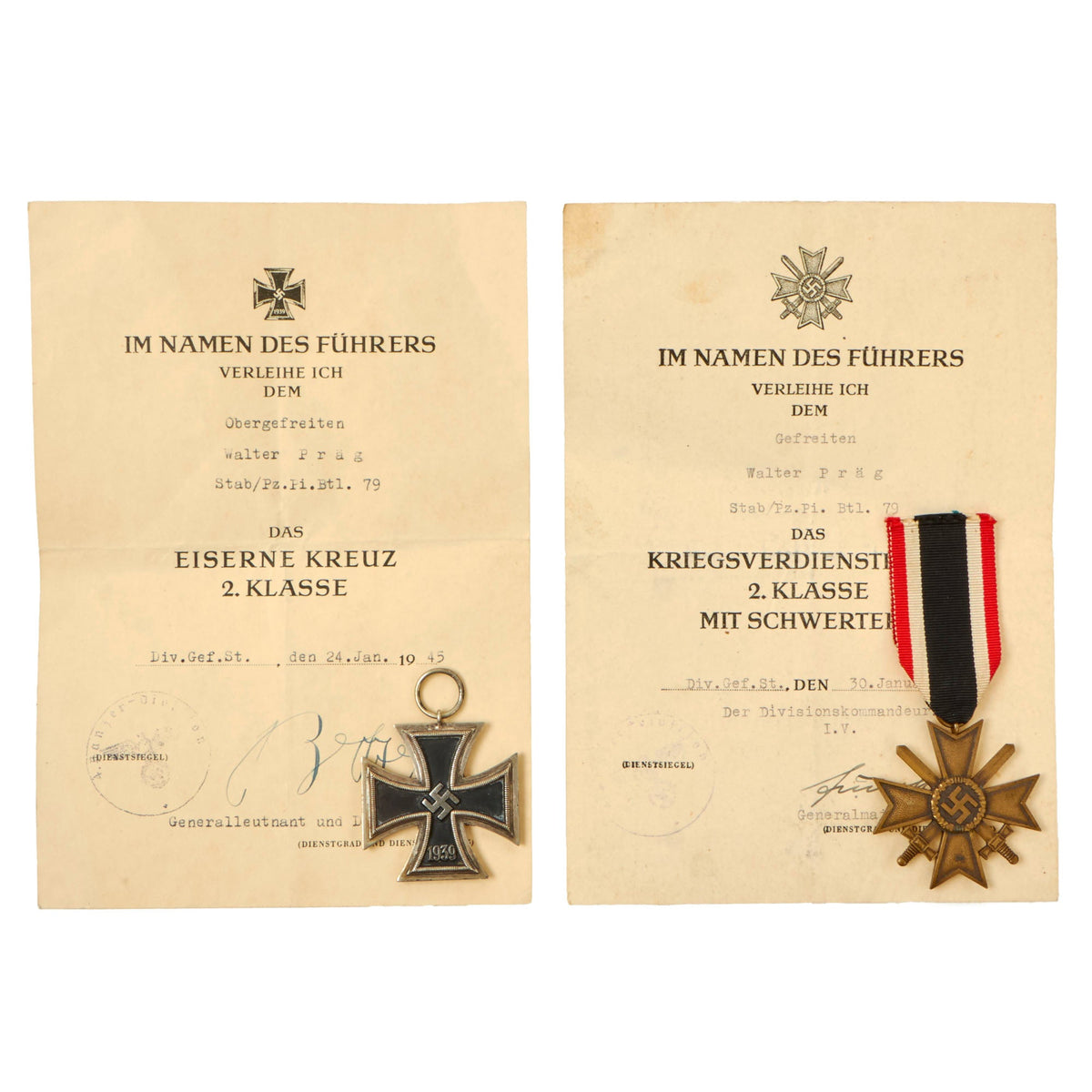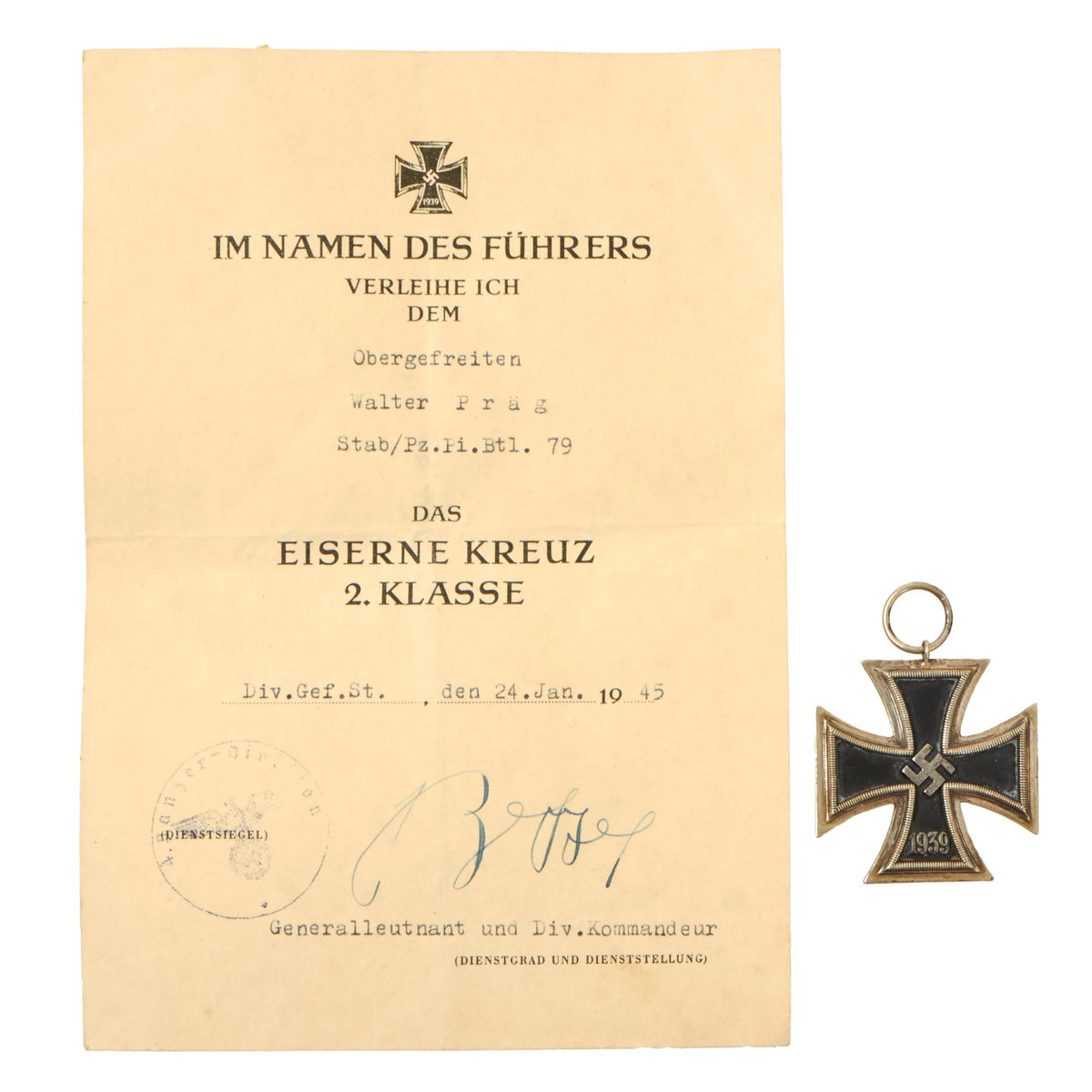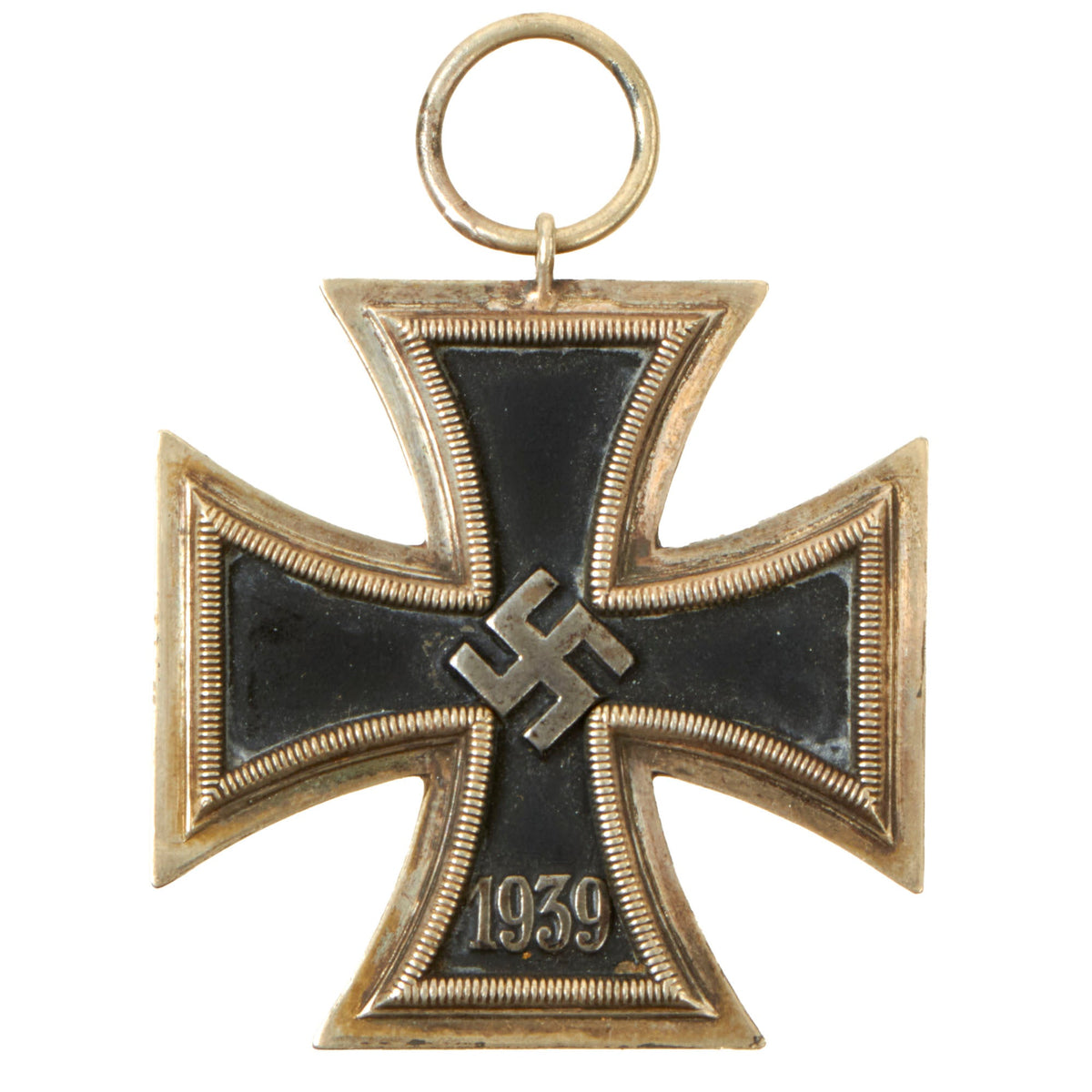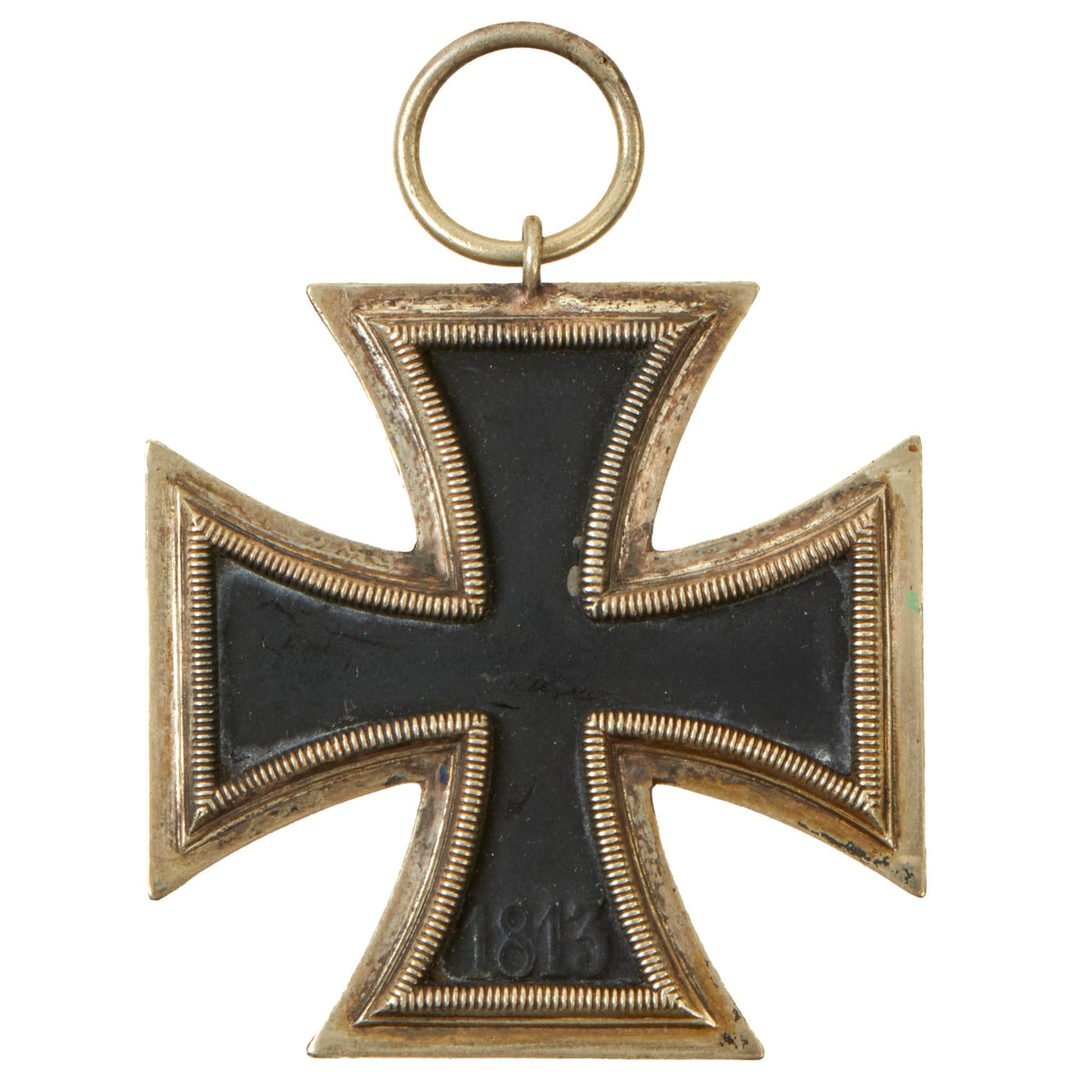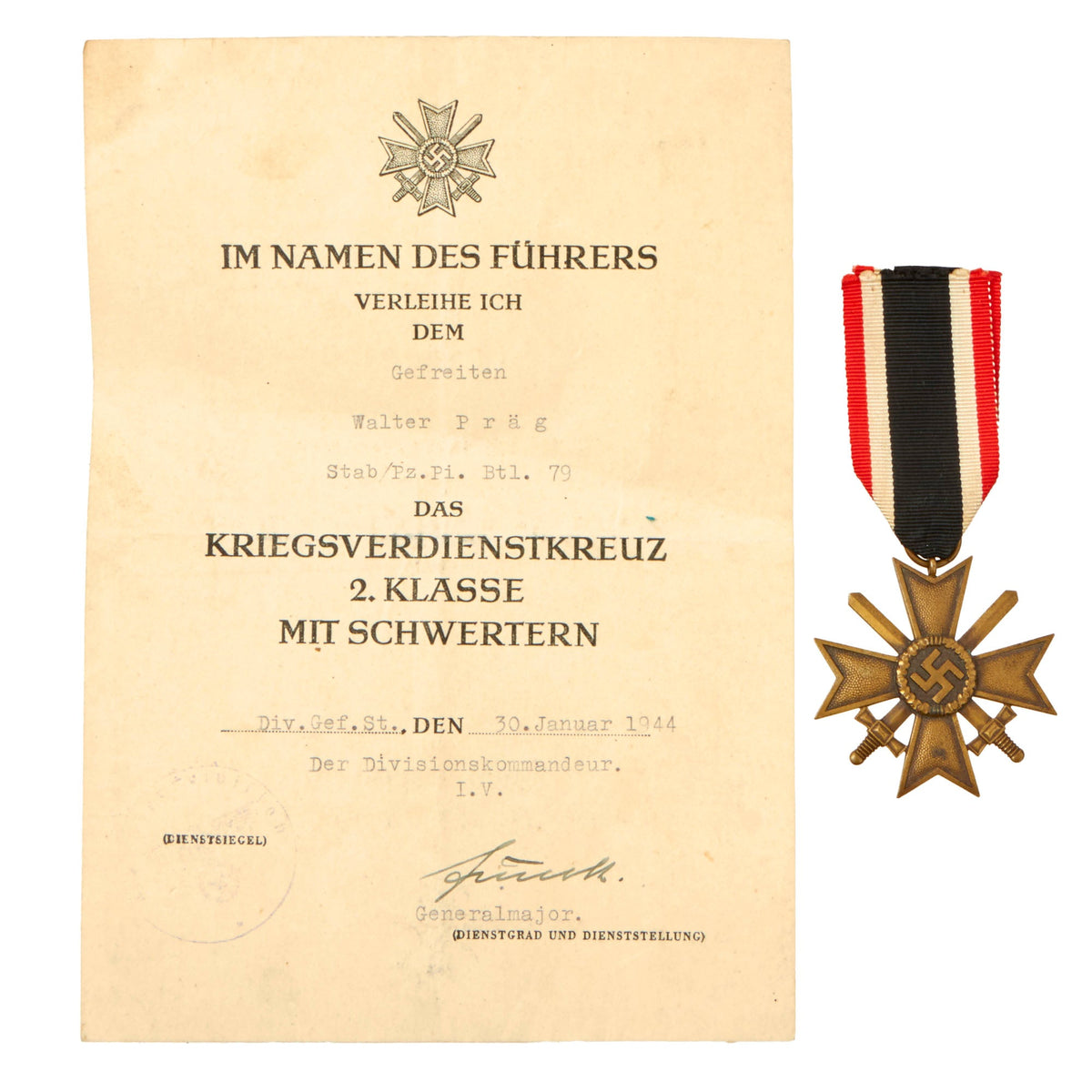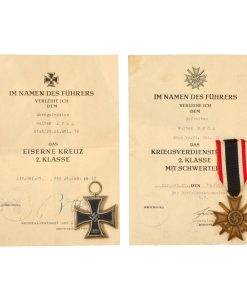Original German WWII EKII and KvKII with Documents Named to Obergefreiter Walter Präg of Panzer Pioneer Battalion 79 – 4th Panzer Division Original Items
$ 495,00 $ 148,50
Original Items: One-of-a-kind grouping. This is a fantastic named Heer Panzer award and document set, with two original German WWII awards, each with their original BESITTZZEUGNIS “possession/award” certificates. Both are named to the same soldier, Walter Präg. The earlier document lists him as a Gefreiten (Exempted), an enlisted rank equivalent to a U.S. Army “Acting” Corporal, while a document dated a year later lists him as a Obergefreiten (Senior exempted), equivalent to a U.S. Army Corporal. This shows his progression over the last years of the war as a senior enlisted man.
The two awards earned by this soldier in date received are the Kriegsverdienstkreuz II. Klasse mit Schwertern (German WWII War Merit Cross 2nd Class with Swords – KvKII), and the Eisernes Kreuz II. Klasse 1939 (Iron Cross 2nd Class 1939 – EKII). Both awards are in very good condition, showing light wear and age. The KvKII still has the original ribbon, while the EKII does not.
Both of the documents measure approximately, 8″ x 5.5″, (20cm x 14cm), and are printed on mid-weight paper with black print and typed in particulars. All of the documents are dated, with their correct stamps and signatures. Both indicate that Präg was a member of Stab / Pz. Pi. Btl. 79, which is an abbreviation for Stab / Panzer Pioniere Battalion 79, or the “Staff, 79th Panzer Pioneer / Combat Engineer Battalion”.
The first award document indicates that the War Merit Cross 2nd Class was awarded to Präg on 30. Januar. 1944, when he held the rank of Gefreiten. This document bears the stamp of the 4. Panzer-Division, and as best we can tell was signed by Division Commander Generalmajor Hans Junck, who was shortly thereafter promoted to Generalleutnant.
The second document indicates that the Iron Cross 2nd Class was awarded to Präg on 24. Jan. 1945, when he held the rank of Obergefreiten. This document also bears the stamp of the 4. Panzer-Division, and was signed by Generalleutnant und Div.Kommandeur Clemens Betzel. He was awarded the Knight’s Cross of the Iron Cross, on 5 September 1944 while 4th Division Commander, and would later receive the Oak Leaves device on 11 March 1945 in the same command. Betzel was later killed by a shell fragment on 27 March 1945 during the Soviet East Pomeranian Offensive. It’s very rare to have a period document signed by a Knight’s cross recipient.
All documents are in good condition, with the expected wear and yellowing from age. They all show folding and light staining, as expected of documents of this age. Please consult the pictures for condition specifics.
A really nice German WWII award set, complete with the original documents named to the same soldier, who was a member of the same unit for a long time. Ready to display!
There is no more iconic German military award than the Iron Cross (Eisernes Kreuz, abbreviated EK). The long history of this order began during the Napoleonic Wars. It was established by King Friedrich Wilhelm III of Prussia in March 1813, backdated to the birthday of his late wife Queen Louise on 10 March 1813 (EK 1813), who was the first person to receive this decoration (posthumous). The award criteria changed somewhat with time, but generally speaking, Iron Crosses could be awarded for individual acts of bravery, or for leadership achievements on the battlefield. The design was created by a Karl Friedrich Schinkel, his choice of the black cross with silver outline was derived from the heraldic emblem of the Teutonic Knights.
There were a number of different type and grades of Iron Cross awards throughout its long history, but the basic details of the most widely awarded grades: The Iron Cross 1st Class and Iron Cross 2nd Class- remained the same. The first class award was a breast badge, with fittings on the reverse to allow it to be worn on the uniform. These fittings varied widely over time and from maker to maker, and could be a simple in and catch, a screw post and retaining disc, or more elaborate setups. The second class award was suspended from a ribbon, originally in the Prussian colors of black and white, later in the Reich colors of black, red and white.
On the original versions of these crosses, in 1813, the front of the iron core of each grade was bare, and only the second class award had ornamentation: a crown over the initials “FW” representing the King, a sprig of oak leaves, and the date 1813. The core was redesigned in 1870, when the cross was re-instituted during the Franco-Prussian War. The reverse ornamentation on the Iron Cross 2nd Class remained the same, but the front of the core on both grades now bore another crown, a “W” representing Kaiser Wilhelm, and the date 1870. This pattern repeated again when the cross was reinstituted for WWI- everything stayed the same, only the date 1870 was replaced with 1914.
The final reinstitution of the cross came in 1939. For this version, the front of the core for both grades bore a swas and the date 1939. The oak leaves, crown and royal initials were removed from the reverse, with only the date 1813 remaining as a reminder of the legacy of this award. In WWII, hundreds of thousands of Iron Cross First Class awards were bestowed, and four and a half million Iron Cross Second Class awards. Iron Crosses were made by a large number of authorized manufacturers. Some variants of these awards were mass produced in huge numbers. Others were made in very limited quantities.
The Iron Cross was normally a military decoration only, though there were instances of it being awarded to civilians for performing military functions. Two examples of this were civilian test pilots Hanna Reitsch who was awarded the Iron Cross 2nd Class and 1st Class and Melitta Schenk Gräfin von Stauffenberg, who was awarded the Iron Cross 2nd Class, for their actions as pilots during World War II.
War Merit Cross 2nd Class (Kriegsverdienstkreuz) with Swords (for Combat)
This was a decoration of NSDAP Germany during the Second World War, which could be awarded to military personnel and civilians alike. By the end of the war it was issued in four degrees, and had a related civil decoration. It was created by Adolf AH in October 1939 as a successor to the non-combatant Iron Cross which was used in earlier wars. The award was graded the same as the Iron Cross: War Merit Cross Second Class, War Merit Cross First Class, and Knights Cross of the War Merit Cross. The award had two variants: with swords given to soldiers for exceptional service “not in direct connection with combat”, and without swords for meritorious service to civilians in “furtherance of the war effort”. As with the Iron Cross, Recipients had to have the lower grade of the award before getting the next level.
Fast Shipping with Professional Packaging
Thanks to our longstanding association with UPS FedEx DHL, and other major international carriers, we are able to provide a range of shipping options. Our warehouse staff is expertly trained and will wrap your products according to our exact and precise specifications. Prior to shipping, your goods will be thoroughly examined and securely secured. We ship to thousands clients each day across multiple countries. This shows how we're dedicated to be the largest retailer on the internet. Warehouses and distribution centres can be located throughout Europe as well as the USA.
Note: Orders with more than one item will be assigned a processing date depending on the item.
Before shipping before shipping, we'll conduct a thorough inspection of the items you have ordered. Today, the majority of orders will be delivered within 48 hours. The delivery time will be between 3-7 days.
Returns
The stock is dynamic and we cannot completely manage it because multiple stakeholders are involved, including our factory and warehouse. So the actual stock may alter at any time. It's possible that you may not receive your order once the order has been made.
Our policy is valid for a period of 30 days. If you don't receive the product within 30 days, we are not able to issue a refund or an exchange.
You can only return an item if it is unused and in the same state as the day you received it. You must have the item in its original packaging.
Related products
Uncategorized
Uncategorized
Uncategorized
Uncategorized
Uncategorized
Uncategorized
Uncategorized
Uncategorized
Uncategorized
Uncategorized
Uncategorized
Uncategorized
Uncategorized
Uncategorized
Angolan Rebel 1970s era 60mm Inert Display Mortar from Angolan Civil War Original Items
Uncategorized
Band of Brothers ORIGINAL GERMAN WWII Le. F.H. 18 10.5cm ARTILLERY PIECE Original Items
Uncategorized
Australian WWII Owen MK1 Machine Carbine SMG Custom Fabricated Replica with Sling Original Items
Uncategorized
Armoured Fighting Vehicles of the World: AFVs of World War One (Hardcover Book) New Made Items
Uncategorized
